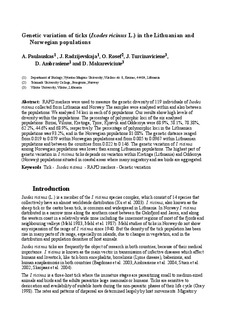Genetic variation of ticks (Ixodes ricinus L.) in the Lithuanian and Norwegian populations
Paulauskas, Algimantas; Radzijevskaja, Jana; Rosef, Olav; Turčinavičienė, Jurga; Ambrasiene, Daiva; Makareviciute, Dovile
Journal article, Peer reviewed
Permanent lenke
http://hdl.handle.net/11250/2437918Utgivelsesdato
2006Metadata
Vis full innførselSamlinger
Originalversjon
Experimental & applied acarology 40(2006) No. 3-4, p. 259-270 http://dx.doi.org/10.1007/s10493-006-9035-0Sammendrag
RAPD markers were used to measure the genetic diversity of 119 individuals of Ixodes ricinus collected from Lithuania and Norway. The samples were analysed within and also between the populations. We analysed 74 loci in each of 6 populations. Our results show high levels of diversity within the populations. The percentage of polymorphic loci of the six analysed populations: Birzai, Vilnius, Kretinga, Tjore, Kjosvik and Odderoya were 68.9%, 58.1%, 78.38%, 62.2%, 44.6% and 68.9%, respectively. The percentage of polymorphic loci in the Lithuanian populations was 93.2%, and in the Norwegian populations 81.08%. The genetic distance ranged from 0.019 to 0.079 within Norwegian populations and from 0.005 to 0.0967 within Lithuanian populations and between the countries from 0.022 to 0.146. The genetic variation of I. ricinus among Norwegian populations was lower than among Lithuanian populations. The highest part of genetic variation in I. ricinus ticks depends on variation within Kretinga (Lithuania) and Odderoya (Norway) populations situated in coastal areas where many migratory and sea birds are aggregated.
